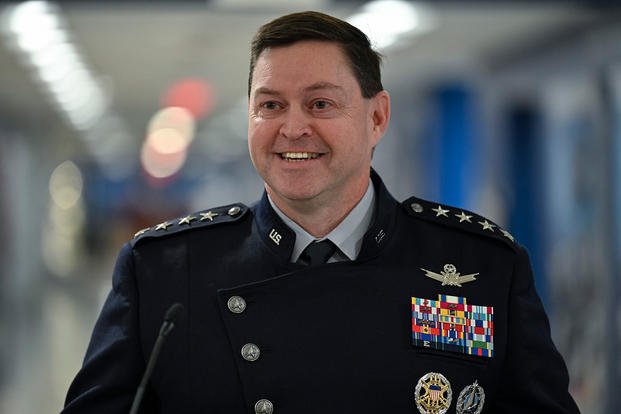

Gen. Chance Saltzman, the top military leader of the Space Force, highlighted five former Air Force reservists during a keynote speech at an annual conference this week, revealing they were among the first service members to transfer into jobs in his service.
For now, the initiative allowing such reservists to transfer to the Space Force is accepting only those who are willing to serve full time as Guardians on active duty. The service is hoping to eventually allow part-time Space Force service as an option to those in the Air Force Reserve.
But many of the basic details of a part-time model — most notably, making sure newly transferred Guardians would get paid — still need to be worked out, Saltzman said during an Air and Space Forces Association conference in the Washington, D.C., area. The effort also comes amid a national debate over a potential alternative, the creation of a Space National Guard manned by part-time troops.
Read Next: Veterans Benefits Safe After Senate Approves $3 Billion in Additional Funding Before Deadline
“We do not want to hurt anybody in the transition period,” Saltzman said. “That is first and foremost in all our minds. And when I say hurt, I mean when you cross over, you don’t get paid — that’s a problem. Our databases for the Space Force don’t include how you bill part-time hours. That’s done over in the Air Force. We need to migrate those capabilities over so that we can manage our force from a part-time standpoint.”
In a separate conference discussion with reporters Tuesday, Chief Master Sergeant of the Space Force John Bentivegna told Military.com that the service wants the new part-time model to be a unique experience and one that doesn’t mirror the existing reserve system.
Back in May, the service began asking for Air Force reservists to transfer to the Space Force full time.
“The reason that’s first is because we know how to pay, we know how to track and compensate someone in a full-time status,” Bentivegna said. “The part time is where we’re trying to work through … We’re not recreating the reserve construct within the Space Force. So, it’s a completely different philosophy. We call it part-time work, which is different.”
The Space Force won’t be accepting applications for part-time service until at least 2026. But a separate push to create a Space Force National Guard is still gaining steam and placing tension on the smallest service’s plans for how it will handle non-active-duty forces.
Former President Donald Trump said last month during a National Guard Association of the United States, or NGAUS, conference in Michigan that he promised to create a Space National Guard if reelected to the White House in November. The suggestion was met with applause from the crowd.
Retired Maj. Gen. Francis McGinn, the NGAUS president, said in a statement following Trump’s comments that he was “grateful” for the former president’s pledge.
“NGAUS has maintained for several years that a Space National Guard is the ideal supplement for the U.S. Space Force,” McGinn said. “We look forward to working with policymakers from both sides of the political aisle to accomplish this goal.”
The Department of the Air Force and the White House have opposed the creation of a Space National Guard, claiming it would be too costly a measure, and instead pushed for the part-time Space Force model instead.
Early this year, in April, Military.com reported that the Air Force had floated a legislative proposal to transfer several hundred Air National Guardsmen who specialize in space missions in states across the country into the active-duty Space Force.
That proposal seeks exceptions from current U.S. law to sidestep governors who oppose transferring those personnel into permanent, active federal service.
The Republican-controlled House and the Democratic-led Senate will eventually agree to a compromise between the two versions of the Air Force’s proposal in the draft versions of the National Defense Authorization Act. The House’s version would allow governors to sign off on the move, and the Senate’s version would limit the move to six states and roughly 600 airmen.
The delay in getting the Space Force’s part-time model up and running is a concern for National Guard lobbyists, who have said many of those Air National Guardsmen in space missions may not have a similar job that offers part-time flexibility for them if the Air Force’s proposal comes to fruition.
McGinn said in a statement after the Air Force’s proposal was publicized in April that “there is no place for them in the Space Force, which currently has no part-time positions, and won’t have any, according to officials, for many years.”
However, Saltzman was optimistic about the five reservists-turned-Guardians he introduced during his keynote speech, saying their experience will pave the way for future transfers into the service and, one day, those seeking to serve part-time, too.
“We’re excited to welcome the many others who will follow in your wake,” Saltzman said. “And the lessons we will learn from you guys is going to shape our efforts moving forward.”
Related: Trump Vows to Create Space National Guard as Issue Becomes a Political Lightning Rod Among States
